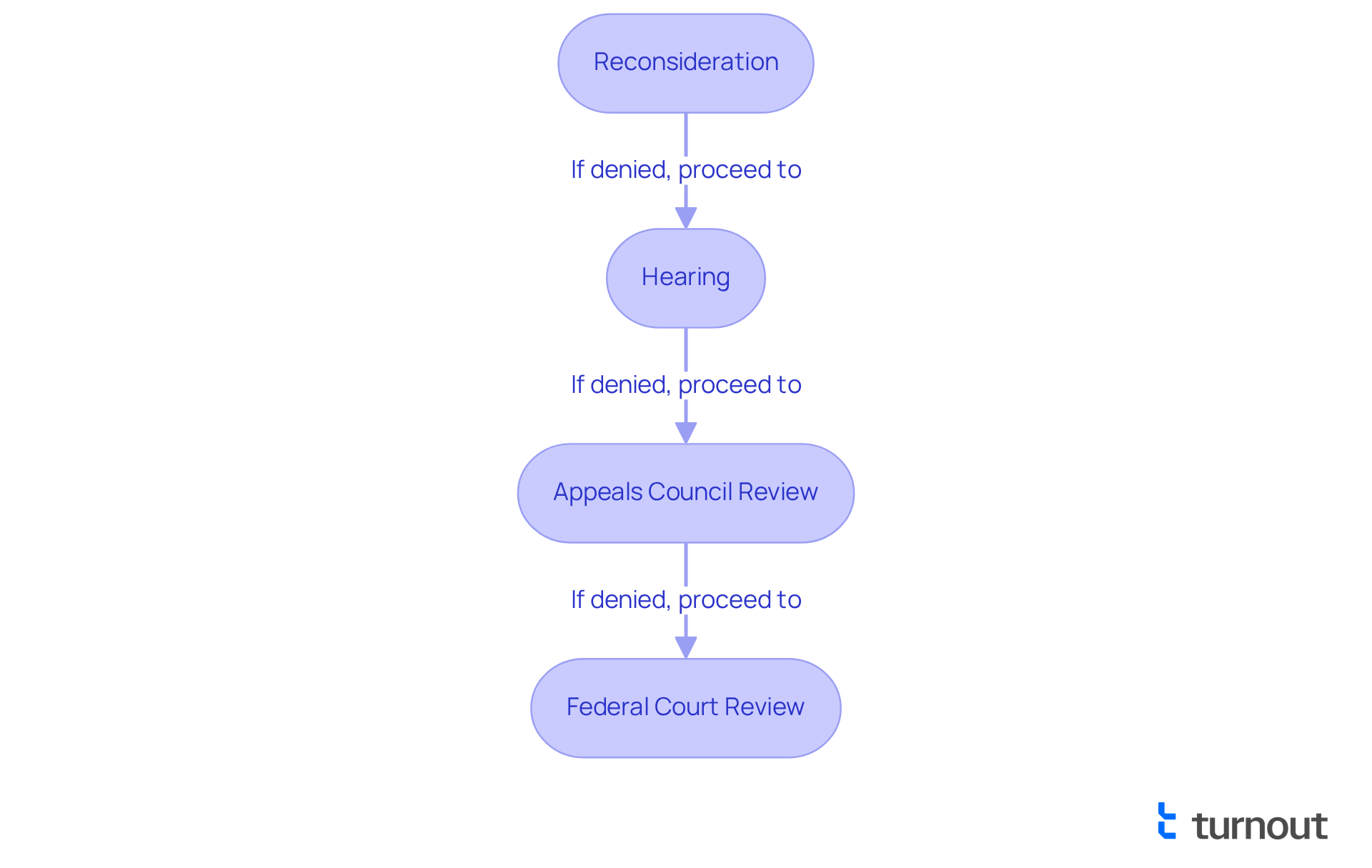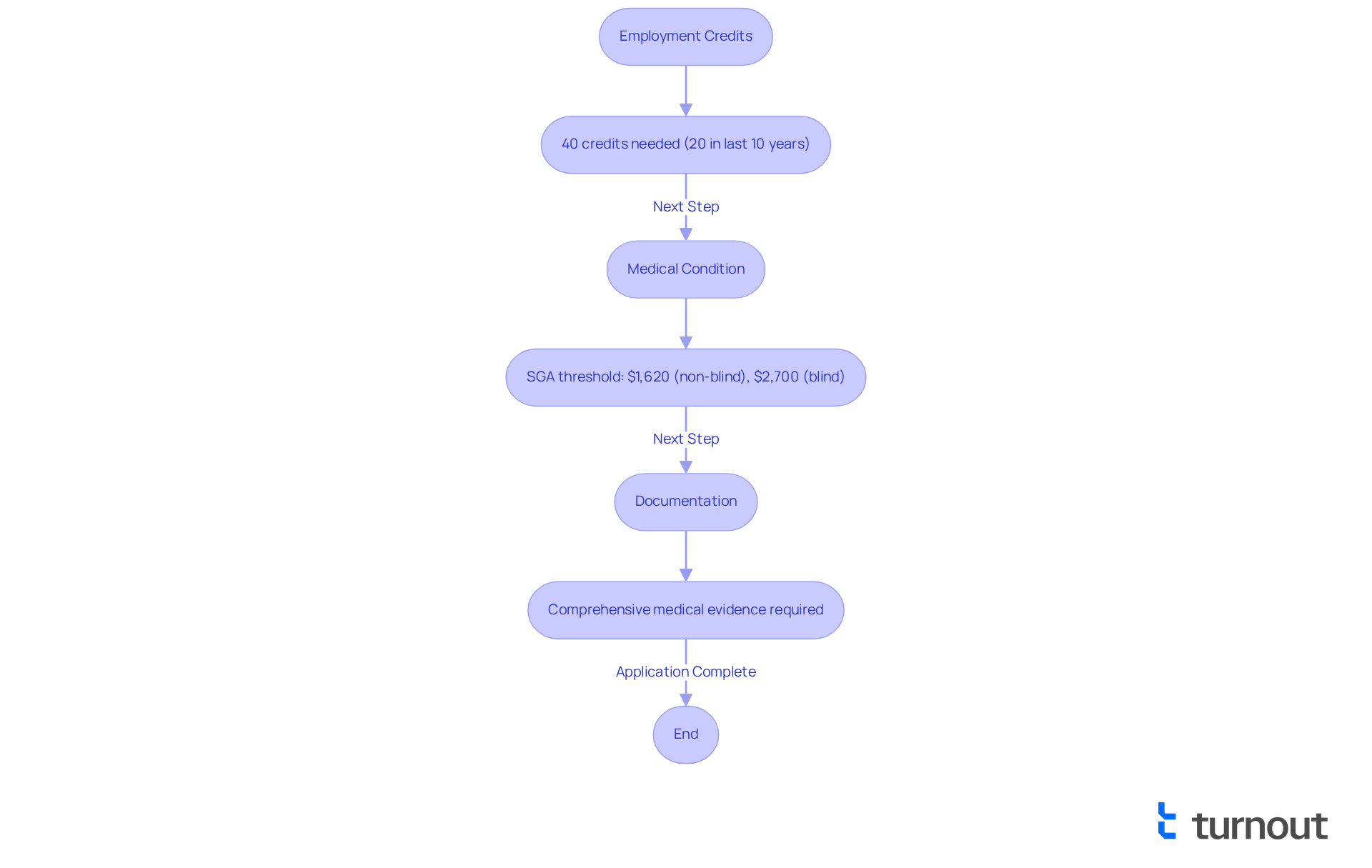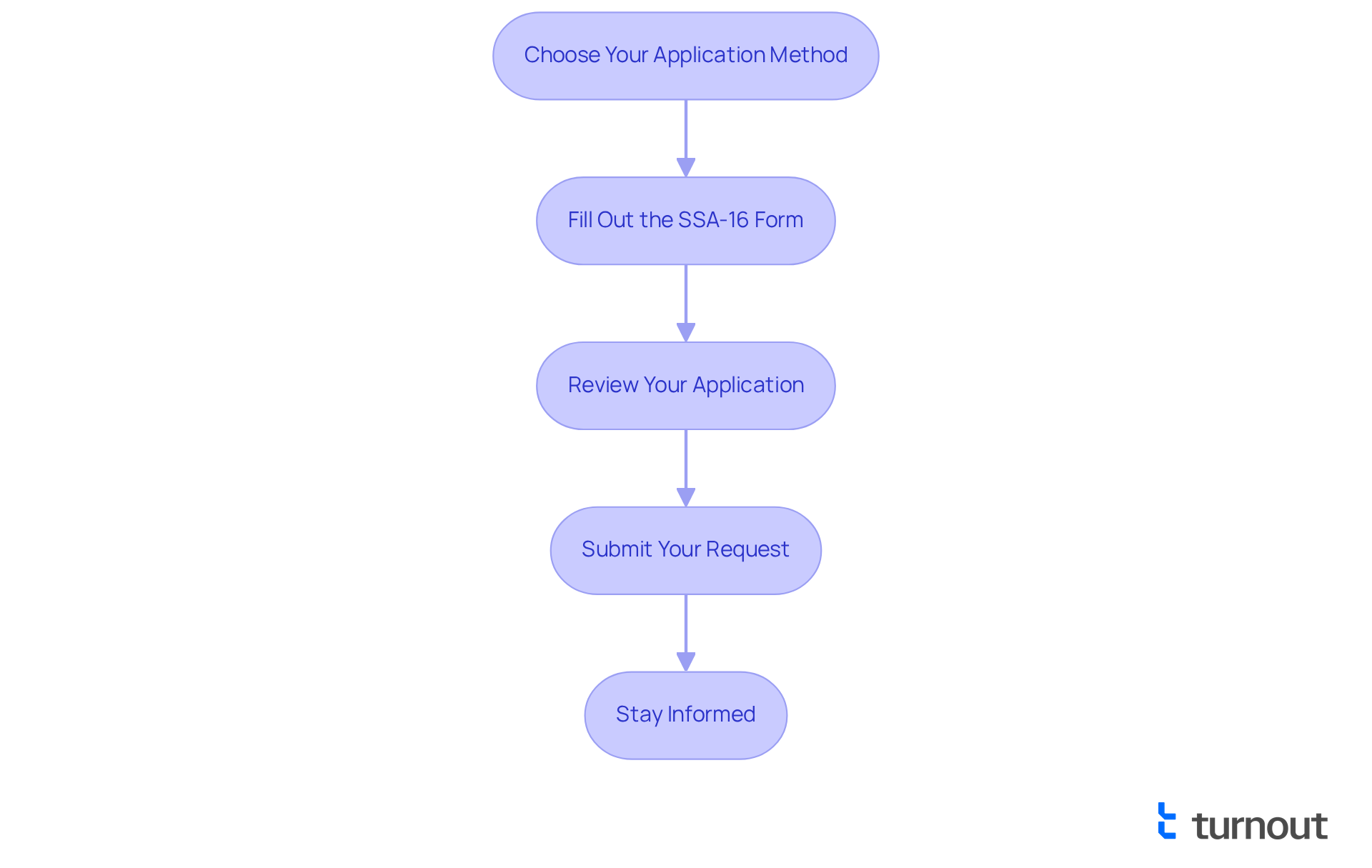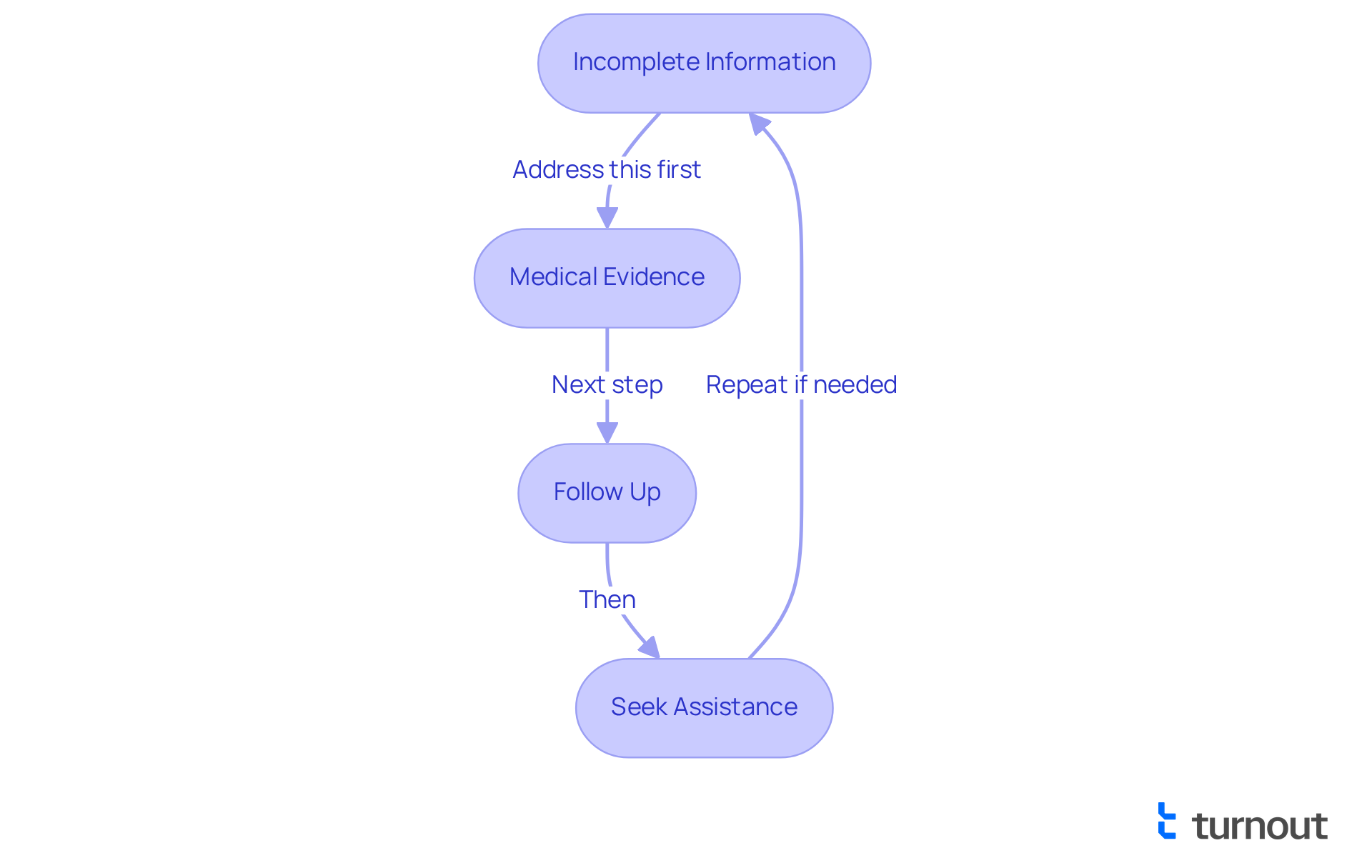Overview
The main focus of this article is to guide you through the essential steps for successfully applying for Social Security Disability Insurance (SSDI) benefits. We understand that this process can be overwhelming, and it’s important to know that you’re not alone in this journey.
By understanding the eligibility criteria, gathering comprehensive documentation, and effectively navigating the application process, you can significantly influence your likelihood of approval, especially considering the challenging approval rates.
Remember, we’re here to help you every step of the way.
Introduction
Navigating the complexities of Social Security Disability Insurance (SSDI) can feel overwhelming. We understand that the stakes are high for those unable to work due to significant disabilities. In 2022, only 35% of initial claims were approved, making it essential to grasp the intricacies of the application process to improve your chances of success.
This guide outlines five crucial steps that empower you to effectively manage your SSDI applications, from determining eligibility to troubleshooting common pitfalls:
- Determine your eligibility
- Gather necessary documentation
- Complete the application accurately
- Follow up on your claim status
- Seek assistance if needed
What strategies can you employ to enhance your application and secure the benefits you deserve? You're not alone in this journey, and we're here to help.
Understand Social Security Disability Insurance (SSDI)
The application for SSDI disability is a vital federal program that provides financial assistance to individuals who are unable to perform tasks due to significant disabilities. We understand that navigating this process can be daunting. To qualify, applicants typically need to demonstrate a sufficient employment history, which usually requires 40 credits, with a maximum of four credits earned annually. In 2025, the substantial gainful activity (SGA) limit for non-blind individuals is projected to be $1,530 per month, while for blind individuals, it is expected to be $2,550. These thresholds are crucial as they determine eligibility based on your ability to engage in work.
It's common to feel overwhelmed by the challenges of the application for SSDI disability benefits request process. In 2022, only about 35% of initial disability claims were approved, and approximately 70% of initial disability and SSI requests were denied. This highlights the difficulties many face. For instance, individuals with severe conditions may find their claims denied due to insufficient medical documentation or failure to meet the SGA criteria. However, understanding the eligibility requirements and preparing thorough documentation for your application for SSDI disability can significantly improve your chances of approval.
Recent updates for 2025 include a 2.5% cost-of-living adjustment (COLA), which will raise average monthly disability payments from $1,542 to $1,580. Additionally, proposals are in place to streamline the application process, potentially allowing for faster approvals for those with clearly disabling conditions.
Advocates emphasize the importance of comprehending the eligibility criteria for the application for SSDI disability benefits. As one specialist noted, "Comprehending disability benefits eligibility criteria is essential for individuals pursuing financial support because of a disabling condition." Furthermore, the Disability Law Group reassures, "If your claim is denied, do not be discouraged—you have the right to appeal." This knowledge empowers you to navigate the complexities of the application for SSDI disability effectively, ensuring you receive the benefits you deserve.
If your disability claim is denied, remember that you have the right to appeal through a four-step procedure:
- Reconsideration
- Hearing
- Appeals Council Review
- Federal Court Review
Understanding this process can provide you with the necessary tools to pursue your claims further. You are not alone in this journey; we’re here to help you every step of the way.

Determine Your Eligibility for SSDI Benefits
Determining your eligibility for an application for SSDI disability benefits can feel overwhelming, but understanding the criteria can help make your journey easier. We're here to guide you through this process with care and compassion.
-
Employment Credits: Generally, you will need 40 employment credits, with at least 20 earned in the last 10 years before your disability began. However, if you are younger, you may qualify with fewer credits. For example, individuals under 24 might only need 6 credits to be eligible.
-
Medical Condition: Your disability must be significant enough to prevent you from engaging in any substantial gainful activity (SGA) for at least 12 months or expected to result in death. In 2025, the SGA threshold is set at $1,620 per month for non-blind individuals and $2,700 for blind individuals. Keep in mind that eligibility can also be influenced by cost-of-living adjustments and revised earnings thresholds in 2025.
-
Documentation: Providing comprehensive medical evidence is crucial to support your claim. This documentation should clearly illustrate how your condition affects your ability to work. It's important to note that about two-thirds of initial disability claims are rejected, often due to insufficient evidence. Ensuring you have the right documentation can significantly improve your chances of approval.
We understand that navigating these criteria can be challenging, but comprehending them is essential for effectively managing your application for SSDI disability benefits. As disability rights advocates remind us, "Work credits are essential for establishing eligibility, and thorough documentation is key to a successful claim." Remember, you are not alone in this journey—we're here to help you every step of the way.

Gather Required Documentation for Your Application
Before you submit your application for ssdi disability, it’s important to gather the necessary documentation to support your request. We understand that this process can feel overwhelming, but having everything in order can make a significant difference.
- Personal Information: Start by including your Social Security number, birth certificate, and proof of U.S. citizenship or lawful alien status.
- Medical Records: It’s crucial to compile detailed medical records from your healthcare providers. This should encompass your diagnoses, treatment history, and relevant test results. Remember, the application for ssdi disability often hinges on comprehensive medical documentation.
- Employment History: Provide a detailed employment history that lists your job titles, dates of service, and descriptions of your job responsibilities. This information is vital for establishing your eligibility based on work credits.
- Financial Information: Don’t forget to record your income and resources, including bank statements and tax returns, as this will assist your request.
As you prepare for 2025, please be aware of updated documentation requirements, which may include additional forms or evidence to substantiate your claims. Typically, disability benefit requests need approximately 15 to 20 documents. Incomplete submissions can lead to considerable delays or outright rejections. We want you to succeed, and supporters emphasize that comprehensive documentation greatly improves the likelihood of a successful application for ssdi disability submission. One supporter even declared, 'Having complete and precise records is essential for effectively managing the system.' For a complete checklist, we encourage you to refer to the SSA's Adult Disability Starter Kit. Remember, you’re not alone in this journey, and we’re here to help you every step of the way.

Complete and Submit Your SSDI Application
To successfully complete and submit your SSDI application, we invite you to follow these essential steps:
-
Choose Your Application Method: You can apply online via the SSA website, by phone, or in person at your local SSA office. We understand that the online method is often the most efficient, especially with the SSA's recent updates aimed at expediting the process.
-
Fill out the application for SSDI disability using the SSA-16 form. It's important to ensure that all sections are completed precisely and comprehensively, particularly your medical history and employment experience. Common mistakes in the application for SSDI disability include omitting critical medical details or failing to provide complete work history, which can lead to unnecessary delays or denials.
-
Review Your Application: We encourage you to carefully double-check for any errors or missing information. Incomplete submissions for an application for SSDI disability can significantly prolong the review process, especially with the SSA currently facing a backlog of approximately 575,000 requests, including about 140,000 claims that have been waiting at least 60 days to be processed. Ensuring accuracy can help avoid these pitfalls.
-
Submit Your Request: Once you feel confident that your request is complete, submit it through your chosen method. If applying online, make sure to receive and save a confirmation of submission for your records. This step is crucial for your peace of mind.
-
Stay Informed: We recommend monitoring your status and being ready to address any requests for further information from the SSA. The typical duration to handle disability claims can fluctuate, but taking initiative can assist in speeding up your case.
For additional help with the application for SSDI disability, we encourage you to consult the SSA's guide, which offers comprehensive directions and resources to aid your submission. Remember, you are not alone in this journey; we’re here to help.

Troubleshoot Common Application Issues
If you encounter issues during your application for SSDI disability process, we understand how challenging this can be. Here are some troubleshooting tips that may help you navigate through:
-
Incomplete Information: It's essential to ensure that all sections of your submission are filled out completely. Lacking information can lead to considerable delays. With the backlog of initial disability requests surpassing 1.4 million, thoroughness is crucial to avoid unnecessary holdups.
-
Medical Evidence: If your request is denied due to inadequate medical evidence, don’t be discouraged. Collect further documentation from your healthcare providers and resubmit your claim. Advocates emphasize that strong medical evidence is vital for a successful appeal, as many claims are initially rejected for this reason.
-
Follow Up: After submitting your request, we encourage you to regularly check the status by contacting the SSA or using their online portal. With average wait times for initial decisions now nearly eight months—double the pre-pandemic duration—proactive follow-up can help you address any issues promptly.
-
Seek Assistance: If you face persistent challenges, consider consulting with a disability benefits advocate or attorney who can provide personalized guidance and support. T.J. Geist, a principal advocate at Allsup, notes that starting with expert assistance can help claimants avoid common pitfalls and strengthen their cases.
By addressing these common issues, you can enhance your application for SSDI disability and increase the likelihood of a favorable outcome. Remember, you are not alone in this journey; we’re here to help.

Conclusion
Navigating the application process for Social Security Disability Insurance (SSDI) can feel overwhelming. We understand that many individuals face significant challenges during this journey. However, knowing the essential steps and requirements can greatly enhance your chances of success. By familiarizing yourself with eligibility criteria, gathering comprehensive documentation, and following a structured application process, you can position yourself more favorably for approval.
This article highlights critical components, such as:
- The importance of employment credits
- The necessity of thorough medical evidence
If your claim is denied, knowing the steps to take can be invaluable. It's common to feel discouraged, but meticulousness in completing the application and staying informed throughout the process can make a significant difference. Each of these elements plays a pivotal role in improving your chances of receiving the benefits you deserve.
Ultimately, the quest for SSDI benefits is more than just a bureaucratic task; it is a vital lifeline for many individuals facing significant disabilities. Therefore, approaching the application process with diligence and determination is crucial. Remember, you are not alone in this journey. If you encounter obstacles, seeking assistance from professionals can provide valuable support and guidance. Empowerment through knowledge and resources can truly make all the difference in achieving success in your SSDI application journey.
Frequently Asked Questions
What is Social Security Disability Insurance (SSDI)?
SSDI is a federal program that provides financial assistance to individuals who are unable to perform tasks due to significant disabilities.
What are the basic eligibility requirements for SSDI?
To qualify for SSDI, applicants typically need to demonstrate a sufficient employment history of 40 credits, with at least 20 earned in the last 10 years before the disability began. Younger individuals may qualify with fewer credits.
What is the Substantial Gainful Activity (SGA) limit for 2025?
In 2025, the SGA limit is projected to be $1,530 per month for non-blind individuals and $2,550 for blind individuals.
What percentage of initial disability claims were approved in 2022?
In 2022, only about 35% of initial disability claims were approved, while approximately 70% of initial disability and SSI requests were denied.
What common reasons lead to the denial of SSDI claims?
Claims are often denied due to insufficient medical documentation or failure to meet the SGA criteria.
How can I improve my chances of SSDI claim approval?
Understanding eligibility requirements and preparing thorough documentation for your application can significantly improve your chances of approval.
What are the recent updates for SSDI in 2025?
A 2.5% cost-of-living adjustment (COLA) will raise average monthly disability payments from $1,542 to $1,580, and proposals are in place to streamline the application process for faster approvals.
What should I do if my SSDI claim is denied?
If your claim is denied, you have the right to appeal through a four-step procedure: Reconsideration, Hearing, Appeals Council Review, and Federal Court Review.
What documentation is necessary to support my SSDI claim?
Comprehensive medical evidence is crucial to illustrate how your condition affects your ability to work. Insufficient evidence is a common reason for claim rejection.
What is the significance of employment credits in SSDI eligibility?
Employment credits are essential for establishing eligibility for SSDI benefits, and thorough documentation is key to a successful claim.




